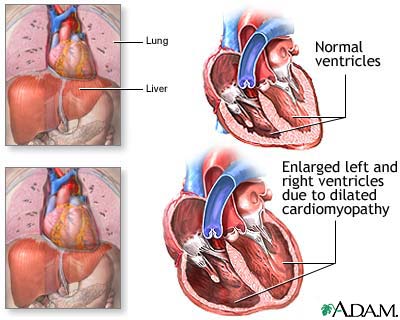
 Symptoms of congestive heart failure
Symptoms of congestive heart failure have a great
impact on a person’s life, considering this is a progressive and
eventually fatal medical condition. Nowadays, in the economic well
developed countries, people die because of the heart problems, more then
they do from any other cause. It is important to know that symptoms of
congestive heart failure have a fluctuating evolution: there are
episodes with severe symptoms, followed by long periods of time when the
situation is stable, nevertheless, even if people recover from the
acute phase, they can’t return to the previous level of functionality.
Also, it is very important to mention that is difficult to predict how
much time is left to live once the diagnosis is established, because
sudden death isn’t uncommon in these patients. Heart failure is not just
a disease of an one individual, but a disease that affects the entire
family.
What do you know about symptoms of congestive heart failure?
If you are one of the patients suffering from congestive heart
failure, you should be informed about the symptoms of congestive heart
failure and when to sick medical help. Every readmission to the hospital
will increase mortality; there are medical articles that suggest a
20-30% increase of this risk with every readmission. You may experience
shortness of breath during effort (exertion dyspnea), during night
(nocturnal paroxysmal dyspnea) or even when you rest( in the advanced
stages of the congestive heart failure). At the beginning, shortness of
breath occurs only during great effort, but in time, daily activities
that once were performed very easily, like dressing, shaving, eating
etc, can produce shortness of breath and force the patient to give up on
his/her social life and depend on other person’s help. Another form of
rest dyspnea is orthopnea, meaning that you can’t breathe while lying in
the bed and you require elevation of the head with pillows.
Other
symptoms of congestive heart failure are palpitations,
rapid heart beats, fatigue, fainting, blue coloring of the lips or limb
extremities, accumulation of water in the limbs tissues (this
condition is called edema) lungs, pleural and abdominal cavities, heart
murmurs.
Because heart can’t deliver enough blood to muscles, patients will
experience weakness and heaviness in the limbs. A low blood flow to the
kidneys will determine oliguria (diminished amount of urine), this
condition appears in advanced stages, when the cardiac output is
severely reduced.
Cerebral manifestations of low cardiac output are also
symptoms of congestive heart failure:
headaches, insomnia, confusion, memory impairment, anxiety or
nightmares. In more severe cases, patients experience other symptoms of
congestive heart failure that require special medical care:
hallucinations, delirium, disorientation.
In the end, we will present a list with a few
symptoms of congestive heart failure,
which may guide patients to require medical help (they were published
in a guide for caregivers, by The Washington Home Center for Palliative
Care Studies):
- gain of 3 pounds or more within a few days or a week,
- increased swelling in hands, ankles or feet,
- difficulty breathing at any time or coughing at night,
- decreased urination,
- confusion, dizziness, or faintness,
- nausea or vomiting,
- increased fatigue,
- muscle cramps or weakness,
- any distressing symptom.
For more info on symptoms of congestive heart failure check with your doctor.











